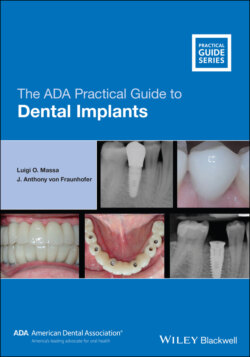Читать книгу The ADA Practical Guide to Dental Implants - J. Anthony von Fraunhofer - Страница 13
Implants and the Edentulous Patient
ОглавлениеOver 32 million people in the U.S. wear partial or CDs [11] and approximately 33% of these patients complain that their dentures fit poorly, tend to loosen or dislodge during activities such as chewing and laughing, and/or there is pain on mastication. Flat ridges and/or shallow palatal vaults add to denture retention and instability problems and most dentists are aware that the mandibular CD presents retention issues.
Table 1.1 Advantages of dental implants.
| Implant dentistry is the future of dentistry.There is copious scientific literature on dental implantology.The 95–97% success rate of dental implants makes them an extremely predictable treatment.There is an overwhelming need for tooth replacement and predictable treatment of failing teeth.Implant‐retained prosthetics are a very satisfactory solution to the growing prevalence of edentulism in our aging population. |
Limitations and/or restrictions on diet, especially which foods can or cannot be eaten, also play a major role in the decision to seek dental implants. It is likely that a significant percentage of those patients experiencing pain or discomfort on chewing will not use their dentures during eating. Due to the decreased mastication forces associated with dentures, edentulous patients have been found to consume less food and have lower intakes of protein, intrinsic and milk sugars, non‐starch polysaccharides (fibrous matter), calcium, non‐heme iron, niacin and vitamin C than dentate people [12]. These dietary deficiencies often have significant adverse effects on overall health and wellbeing, as well as their QoL.
Many patients will resort to utilizing denture adhesives to aid in retention. These adhesives may lead to further problems as they are extremely difficult to remove from the tissues. Impaired speech patterns as well as halitosis (oral malodor or “denture breath”) are frequent complaints among denture wearers, even when the fit of the denture is not a significant issue.
It follows from the above, that patients seek dental implant therapy for a number of reasons, including the following:
Function
Esthetics
Comfort
Confidence
Facial appearance
General dental practitioners can address these issues and assist the patient in achieving oral health and functionality lost through missing teeth.
There are two major implant treatment modalities for the edentulous patient:
1 Implant over‐dentures. Implant overdentures are removable appliances which are both implant and tissue‐borne prostheses. They utilize an abutment and a denture attachment for the retention (Fig. 1.3). These appliances solve several major problems with traditional dentures by allowing:Increased masticatory forcesIncreased retention to potentially eliminate the need for denture adhesivesRemoval of palatal coverage for patients who cannot tolerate the denture due to their gag reflexAn implant‐supported denture is a satisfactory and viable economic alternative to the traditional CD.Screw‐retained fixed implant bridges. Fixed implant bridges are implant‐borne prostheses which are not removable by the patient. They are manufactured in zirconia or in acrylic overlaying a chrome‐cobalt or titanium bar. These appliances give patients the greatest masticatory forces and are more appealing to most patients because they are fixed in place.
